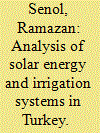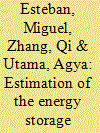|
|
|
Sort Order |
|
|
|
Items / Page
|
|
|
|
|
|
|
| Srl | Item |
| 1 |
ID:
114322


|
|
|
|
|
| Publication |
2012.
|
| Summary/Abstract |
This study discusses four European and American regulatory schemes designed for accounting lifecycle GHG emissions in relation to the Brazilian sugarcane ethanol. The objective is to critically examine the methodologies and associated parameters used in existing regulatory schemes for calculating GHG emissions, and to explore methodological convergences. The issues related to direct lifecycle and indirect land use change emissions have been addressed. It is found that there are commonalities between the European Renewable Energy Directive (EU-RED) and the UK's Renewable Transport Fuels Obligation (UK-RTFO), but the US-EPA's Renewable Fuel Standard (US-EPA) and the Low Carbon Fuel Standard of the California Air Resources Board (CA-CARB) vary greatly not only among themselves, but also in relation to the European regulations. Agricultural practices (especially soil carbon and nitrogen dynamics), co-product credits from surplus electricity and uncertainties around economic modeling approaches for indirect land use change are the major areas where methodological divergences exist. Incorporation of domestic agricultural practices, sugarcane mills operations, and realistic modeling of indirect impacts of land use change using regional models could provide more coherence in estimations of GHG emissions. Furthermore, the Brazilian trend of novelty in all phases of sugarcane bioenergy systems should be considered when projecting GHG emissions.
|
|
|
|
|
|
|
|
|
|
|
|
|
|
|
|
| 2 |
ID:
114331


|
|
|
|
|
| Publication |
2012.
|
| Summary/Abstract |
Pumping water is considered a common need all around the world. Standalone PV technologies are being increasingly used for midsize pumping applications. PV powered pumping systems offer simplicity, reliability, and low maintenance for irrigation systems. PV powered pump is particularly appropriate for water supply in remote areas where no electricity grid is available. In this paper, the technical and economical feasibility of photovoltaic pumping of water in Turkey has been studied. Here, the study has focused on small and medium-size mobile applications using energy and water-conserving forms of drip irrigation to apple orchard on up to 0.5 ha of land in Egirdir District. Life cycle cost (LCC) method has been applied to determine the economic life of the PV modules, and the diesel pumping in Turkey taken as 25 years.
|
|
|
|
|
|
|
|
|
|
|
|
|
|
|
|
| 3 |
ID:
114285


|
|
|
|
|
| Publication |
2012.
|
| Summary/Abstract |
The energy poverty line is defined as the threshold point at which energy consumption begins to rise with increases in household income. This approach is applied to cross-sectional data from a comprehensive 2005 household survey representative of both urban and rural India. The objective is to determine if the energy poor are also income poor and whether and how energy policies help reduce energy poverty, independent of income. The findings suggest that in rural areas some 57% of households are energy poor, versus 22% that are income poor. But in urban areas the energy poverty rate is 28% compared to 20% that are income poor. That is, energy policies are expected to play some roles in mitigating energy poverty. We find that reducing energy poverty requires not only support for rural electrification, but also more use of modern cooking fuels such as LPG. While income growth matters, a combination of energy related programs can play an independent and substantial role in reducing energy poverty.
|
|
|
|
|
|
|
|
|
|
|
|
|
|
|
|
| 4 |
ID:
114316


|
|
|
|
|
| Publication |
2012.
|
| Summary/Abstract |
Based on data from a face-to-face survey of 2422 residents from urban Turkey, this paper presents an analysis of citizens' preferences in Turkey on nuclear and renewable energy sources. Findings indicate that opposition to nuclear power was strong, and only a small number of respondents endorsed it by listing it in their top two choices. Conversely, almost two-thirds of the sample endorsed investment in renewable energy sources (such as wind and solar), and only a small minority was opposed to it. Econometric analyses revealed that knowledge of the climate change problem was a common factor that explained endorsement of both nuclear and renewables. Yet, high levels of concern for the environment and a negative perception regarding its future differentiated the endorsers of renewables from those of nuclear energy. Endorsers of nuclear energy were found to be males who were knowledgeable about climate change and engaged in environmental issues, but less concerned about the environment, and optimistic about its future. Nuclear opponents, on the other hand, were found to be concerned about the environment, pessimistic about its future, and not fully relying on technology.
|
|
|
|
|
|
|
|
|
|
|
|
|
|
|
|
| 5 |
ID:
114315


|
|
|
|
|
| Publication |
2012.
|
| Summary/Abstract |
The international literature has paid significant attention to presenting China as the largest emitter of greenhouse gases (GHGs) in the world, despite having much lower per-capita emissions than the global average. In fact, the imbalance of economic development leads to diversity in GHG emissions profiles in different areas of China. This paper employs a common methodology, consistent with the Sustainable Energy Action Plan (SEAP) approved by the Covenant of Mayors (CoM), to estimate CO2 emissions of four Chinese cities in highly urbanized areas from 2004 to 2010. The results show that the CO2 emissions of all four cities are still rising and that secondary industries emit the most CO2 in these cities. By comparing these data with the inventory results of two European cities, this paper further reveals that Chinese cities in highly urbanized areas contribute much higher per-capita emissions than their European competitors. Furthermore, the per-capita CO2 emissions of the residential sector and private transport in these Chinese cities are growing rapidly, some of them approaching the levels of European cities. According to these findings, several policy suggestions considering regional disparities are provided that aim to reduce the CO2 emissions of highly urbanized areas in China.
|
|
|
|
|
|
|
|
|
|
|
|
|
|
|
|
| 6 |
ID:
114328


|
|
|
|
|
| Publication |
2012.
|
| Summary/Abstract |
Coal power coupled with Carbon [Dioxide] Capture and Storage (CCS), and Concentrating Solar Power (CSP) technologies are often included in the portfolio of climate change mitigation options intended to decarbonize electricity systems. Both of these technologies can provide baseload electricity, are in early stages of maturity, and have benefits, costs, and obstacles. We compare and contrast CCS applied to coal-fired power plants with CSP. At present, both technologies are more expensive than existing electricity-generating options, but costs should decrease with large-scale deployment, especially in the case of CSP. For CCS, technological challenges still remain, storage risks must be clarified, and regulatory and legal uncertainties remain. For CSP, current challenges include electricity transmission and business models for a rapid and extensive expansion of high-voltage transmission lines. The need for international cooperation may impede CSP expansion in Europe.
|
|
|
|
|
|
|
|
|
|
|
|
|
|
|
|
| 7 |
ID:
114298


|
|
|
|
|
| Publication |
2012.
|
| Summary/Abstract |
This paper presents a review undertaken to understand the concept of 'future-proofing' the energy performance of buildings. The long lifecycles of the building stock, the impacts of climate change and the requirements for low carbon development underline the need for long-term thinking from the early design stages. 'Future-proofing' is an emerging research agenda with currently no widely accepted definition amongst scholars and building professionals. In this paper, it refers to design processes that accommodate explicitly full lifecycle perspectives and energy trends and drivers by at least 2050, when selecting energy efficient measures and low carbon technologies. A knowledge map is introduced, which explores the key axes (or attributes) for achieving a 'future-proofed' energy design; namely, coverage of sustainability issues, lifecycle thinking, and accommodating risks and uncertainties that affect the energy consumption. It is concluded that further research is needed so that established building energy assessment methods are refined to better incorporate future-proofing. The study follows an interdisciplinary approach and is targeted at design teams with aspirations to achieve resilient and flexible low-energy buildings over the long-term.
|
|
|
|
|
|
|
|
|
|
|
|
|
|
|
|
| 8 |
ID:
114314


|
|
|
|
|
| Publication |
2012.
|
| Summary/Abstract |
Residential energy-efficient and renewable energy (EERE) products play an important role in energy conservation and carbon emissions reduction. Various financial incentive programs have been developed to promote the adoption of these products. However, their effectiveness in attracting consumers is not very well understood. In this study, we investigated impacts of financial incentives on homeowner's decision making towards six EERE products. Two forms of incentives, tax credits and interest-free loans, were examined through a household mailing survey in Florida, the United States. Results showed that, although half of the respondents were interested in EERE products, the high investment cost was a major concern that hindered their purchase activities. Homeowners were attracted to financial incentives and valued tax credits much higher than interest-free loans. The current federal home energy tax credit levels were found to attract only 2-12 percent of homeowners to buy EERE products. The willingness of participation was especially low for the costly products (such as solar panels). The participation rate was also very low for lower income (i.e., annual household income below $50,000) families living in older residences. This study contributes to the understanding of economic and social aspects of consumer decision making on energy efficiency and alternative energy.
|
|
|
|
|
|
|
|
|
|
|
|
|
|
|
|
| 9 |
ID:
114313


|
|
|
|
|
| Publication |
2012.
|
| Summary/Abstract |
We use the multi-scale power system model LIMES-EU+ to explore coordinated long term expansion pathways for Renewable Energy (RE) generation, long distance transmission and storage capacities for the power sector of the Europe and Middle East/North Africa (MENA) regions that lead to a low emission power system. We show that ambitious emission reduction targets can be achieved at moderate costs by a nearly complete switch to RE sources until 2050, if transmission and storage capacities are expanded adequately. Limiting transmission capacities to current levels leads to higher storage requirements, higher curtailments, and to an increase in temporal and spatial electricity price variations. Results show an escalation of electricity prices if emission reductions exceed a critical value. Adequate expansion of transmission and storage capacities shift this threshold from 70% to 90% emission reductions in 2050 relative to 2010.
|
|
|
|
|
|
|
|
|
|
|
|
|
|
|
|
| 10 |
ID:
114321


|
|
|
|
|
| Publication |
2012.
|
| Summary/Abstract |
We have undertaken a case study of a Combined Heat and Power (CHP) plant applied to a mixture of buildings comprising residential premises, offices, hospitals, stores, and schools in Korea. We proposed five Plans for grouping buildings in the complex and estimated the annual 8760-hourly demands for electricity, cooling, heating, and hot water. For each Plan, we built about ten Scenarios for system construction. Then, we simulated the operation of the system to find the fuel consumption, electricity purchase, and heat recovery. Applying the local rates to the amounts of fuel and electricity, we estimated the operating costs. Combining the operating cost with the initial cost associated with the purchase and construction of the system, we calculated the payback periods for the scenarios. We found that the payback period can be as short as two years for smartly grouped buildings with a generator capacity of around 50% of the peak electricity demand. A progressive electricity rate that applies only to residential premises currently plays a key role in the economic merits. We recommend extending a sound progressive system to other types of building in Korea to promote distributed power production and enhance energy saving practices in general.
|
|
|
|
|
|
|
|
|
|
|
|
|
|
|
|
| 11 |
ID:
114311


|
|
|
|
|
| Publication |
2012.
|
| Summary/Abstract |
The future bioenergy crop potential depends on (1) changes in the food system (food demand, agricultural technology), (2) political stability and investment security, (3) biodiversity conservation, (4) avoidance of long carbon payback times from deforestation, and (5) energy crop yields. Using a biophysical biomass-balance model, we analyze how these factors affect global primary bioenergy potentials in 2050. The model calculates biomass supply and demand balances for eleven world regions, eleven food categories, seven food crop types and two livestock categories, integrating agricultural forecasts and scenarios with a consistent global land use and NPP database. The TREND scenario results in a global primary bioenergy potential of 77 EJ/yr, alternative assumptions on food-system changes result in a range of 26-141 EJ/yr. Exclusion of areas for biodiversity conservation and inaccessible land in failed states reduces the bioenergy potential by up to 45%. Optimistic assumptions on future energy crop yields increase the potential by up to 48%, while pessimistic assumptions lower the potential by 26%. We conclude that the design of sustainable bioenergy crop production policies needs to resolve difficult trade-offs such as food vs. energy supply, renewable energy vs. biodiversity conservation or yield growth vs. reduction of environmental problems of intensive agriculture.
|
|
|
|
|
|
|
|
|
|
|
|
|
|
|
|
| 12 |
ID:
114295


|
|
|
|
|
| Publication |
2012.
|
| Summary/Abstract |
Bürer and Wüstenhagen (2009) examined the preferences of 60 clean-tech venture capital and private equity investors regarding renewable energy and climate policies in 2007. This paper presents the results of a research project that examined whether these investor preferences changed due to the financial crisis. We re-conducted that part of Bürer and Wüstenhagen (2009) survey that focuses on the preferences for 12 market-pull policies. Comparing our results with those from 2007, we found that the popularity of 11 out of 12 policies decreased. The decrease was significant for those policies that involve subsidies and trade related schemes such as CO2 emissions and green certificates trading. The decrease in the popularity of the policies was mainly the result of changes in the preferences of European investors, whereas the preferences of North American investors did not change noteworthy.
|
|
|
|
|
|
|
|
|
|
|
|
|
|
|
|
| 13 |
ID:
114301


|
|
|
|
|
| Publication |
2012.
|
| Summary/Abstract |
The European Union has committed itself to reduce greenhouse gas (GHG) emissions by 20% in 2020 compared with 1990 levels. This paper investigates whether this policy has an additional benefit in terms of economic resilience by protecting the EU from the macroeconomic consequences due to an oil price rise.
We use the GEM-E3 computable general equilibrium model to analyse the results of three scenarios. The first one refers to the impact of an increase in the oil price. The second scenario analyses the European climate policy and the third scenario analyses the oil price rise when the European climate policy is implemented.
Unilateral EU climate policy implies a cost on the EU of around 1.0% of GDP. An oil price rise in the presence of EU climate policy does imply an additional cost on the EU of 1.5% of GDP (making a total loss of 2.5% of GDP), but this is less than the 2.2% of GDP that the EU would lose from the oil price rise in the absence of climate policy. This is evidence that even unilateral climate policy does offer some economic protection for the EU.
|
|
|
|
|
|
|
|
|
|
|
|
|
|
|
|
| 14 |
ID:
114299


|
|
|
|
|
| Publication |
2012.
|
| Summary/Abstract |
Energy managers in public agencies are subject to multiple and sometimes conflicting policy objectives regarding cost, environmental, and security concerns associated with alternative energy technologies. Making infrastructure investment decisions requires balancing different distributions of risks and benefits that are far from clear. For example, managers at permanent Army installations must incorporate Congressional legislative objectives, executive orders, Department of Defense directives, state laws and regulations, local restrictions, and multiple stakeholder concerns when undertaking new energy initiatives. Moreover, uncertainty with regard to alternative energy technologies is typically much greater than that associated with traditional technologies, both because the technologies themselves are continuously evolving and because the intermittent nature of many renewable technologies makes a certain level of uncertainty irreducible. This paper describes a novel stochastic multi-attribute analytic approach that allows users to explore different priorities or weighting schemes in combination with uncertainties related to technology performance. To illustrate the utility of this approach for understanding conflicting policy or stakeholder perspectives, prioritizing the need for more information, and making investment decisions, we apply this approach to an energy technology decision problem representative of a permanent military base.
|
|
|
|
|
|
|
|
|
|
|
|
|
|
|
|
| 15 |
ID:
114325


|
|
|
|
|
| Publication |
2012.
|
| Summary/Abstract |
Working from home is generally perceived as an effective means of reducing energy use and associated pollution from commuter transport. In order to consider the merits of mechanisms and policies to support a change in behaviour that results in greater take-up of home working, this paper applies energy consumption per commute calculations and a logit model using a case study of Ireland. In marked contrast with larger countries, the energy consumption per commute is relatively low in Ireland. Nonetheless, the analysis indicates that, on average, at least an average net saving of 9.33 kW h per day can be achieved where an individual converts to working from home, after deducting the home energy consumption associated with home working. We find that land use patterns, public transport networks, internet infrastructure, commute distances and socio-demographic characteristics can serve to influence rates of home working. Encouraging the higher and lower professional categories and those in the service sectors to work from home should be the highest priority in terms of energy and emissions reductions. Increased coverage of internet services and railway coverage will support higher rates of home working. Increased dispersion of residential, commercial and industrial areas serves to encourage greater home working.
|
|
|
|
|
|
|
|
|
|
|
|
|
|
|
|
| 16 |
ID:
114287


|
|
|
|
|
| Publication |
2012.
|
| Summary/Abstract |
Renewable energy systems are often criticized because of their intermittency and need for substantial amount of backup in terms of other energy sources or storage. The present paper proposes a method to estimate the required amount of storage backup for a mostly solar and wind system that uses also biomass and hydroenergy as minor components of the electricity mix. An hourly simulation was carried out to determine the amount of electricity that could be produced based on the meteorological conditions of year 2001 in Japan, and this was compared with the maximum electricity demands imposed in the system for each month of the year. The system thus proposed has 100% chance of meeting around 40% of the electricity demand between 11:00 and 18:00, and the optimum scenario obtained (a 2:1 mix of solar to wind energy) required around 40 TW of storage to balance the extra electricity demand that occurs during the summer in Japan. It appears unlikely that the batteries in EV in vehicles will be able to meet this storage requirement in the future, though the system is able to adequately meet the electricity demand during the majority of the year, and hence showcases the viability of renewable energy.
|
|
|
|
|
|
|
|
|
|
|
|
|
|
|
|
| 17 |
ID:
114323


|
|
|
|
|
| Publication |
2012.
|
| Summary/Abstract |
Energy prices in Iran have traditionally been heavily subsidized by the Government, and as a result, energy consumption per capita in Iran is close to the European Union level. The welfare effects of efforts to raise energy prices closer to world levels are examined in this paper. Reform of energy prices is an important element of the "Economic Reform Plan" (2010-2014) for Iran. We first analyze the relationship between energy consumption, energy and non-energy prices by estimating the household expenditure function. The results show that a higher energy prices will decrease energy consumption by Iranian households. Second, we evaluate the impact of a rise of energy prices on the household welfare by measuring the compensating variation (CV) in five steps with a compensating payment. The results show that Iranian household welfare will increase with a 100% or 200% rise in energy prices, if the government pays 20%, 30% or 50% of the $20 billion income resulting from removing energy subsidies. While, in contrast, Iranian household welfare will decrease with a 400% and 500% rise in energy prices, if the government payment is 20% or 30% of $20 billion income.
|
|
|
|
|
|
|
|
|
|
|
|
|
|
|
|
| 18 |
ID:
114291


|
|
|
|
|
| Publication |
2012.
|
| Summary/Abstract |
The main purpose of this paper is to investigate whether residents' environmental concern has any effect on their energy-saving curtailments and efficiency investments. The novelty of the present work lies in the fact that it seeks to investigate this topic in a multi-country setting, exploiting data from nine OECD countries (Australia, Canada, Czech Republic, France, Italy, South Korea, Netherlands, Norway and Sweden), and also in that it employs a latent variable model which allows us to examine the conditions necessary for the results to be comparable across different countries. Novel in this paper is also the focus on the role of environmental concern as a factor of several curtailments and efficiency investments. Our results suggest that people with higher environmental concern are on average more likely to perform energy-saving curtailments and also are more likely to have some energy-efficiency retrofits installed in dwellings. Most of the socio-economic and demographic variables have mixed effects on efficiency investments and curtailments. However, some interesting patterns emerged with respect to the age of respondents, household income, education and gender of respondents, and also the size of household.
|
|
|
|
|
|
|
|
|
|
|
|
|
|
|
|
| 19 |
ID:
114320


|
|
|
|
|
| Publication |
2012.
|
| Summary/Abstract |
The labor market implications of large investment into renewable energy (RE) are analyzed in this text. Although a growing RE industry can be observed in Germany the overall effect of large increases of RE based electricity and heat generating technologies on the German economy require a careful model based analysis. The applied model PANTA RHEI has been used among others to evaluate the German energy concept in 2010. It takes positive and negative impacts of RE into account. The paper shows the overall effects under different assumptions for fossil fuel prices, domestic installations and international trade. The results are sensitive to assumptions on the development of RE world markets and German exports to these markets. Almost all of these scenarios exhibit positive net employment effects. Under medium assumptions net employment of RE expansion will reach around 150 thousand in 2030. Only with assumptions for German RE exports below today's level, net impacts are slightly negative. Gross employment will increase from 340 thousand in 2009 to between 500 and 600 thousand in 2030.
|
|
|
|
|
|
|
|
|
|
|
|
|
|
|
|
| 20 |
ID:
114302


|
|
|
|
|
| Publication |
2012.
|
| Summary/Abstract |
This paper analyses the willingness to pay for electricity generated from renewable energy sources in Slovenia. The results confirm that age, household income, education and environmental awareness play the most important role in explaining household attitudes to green electricity programmes. While the willingness to participate in green electricity programmes is influenced by education and environmental awareness, the willingness to pay for green electricity predominantly depends on household income. The results imply that green marketing should be accompanied by awareness-raising campaigns and should target younger, well-educated and high-income households. The expressed median willingness to pay is found to exceed the current level of mandatory charges for green electricity. Nevertheless, recent increases in final electricity prices might have already exhausted the capacity for additional voluntary contributions.
|
|
|
|
|
|
|
|
|
|
|
|
|
|
|
|
|
|
|
|
|